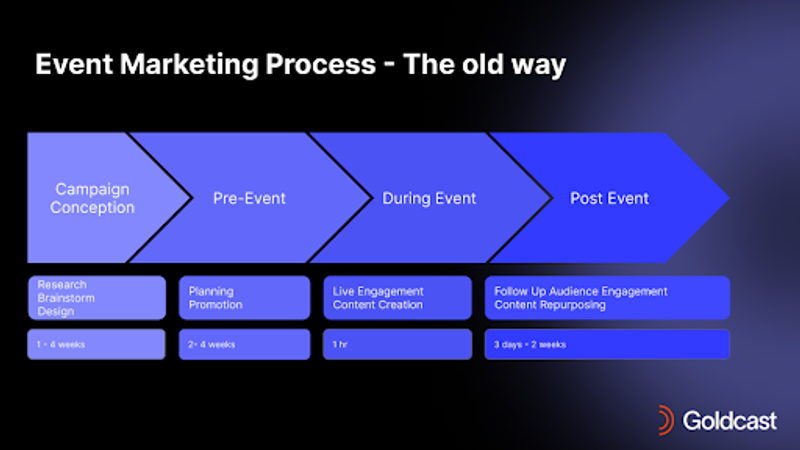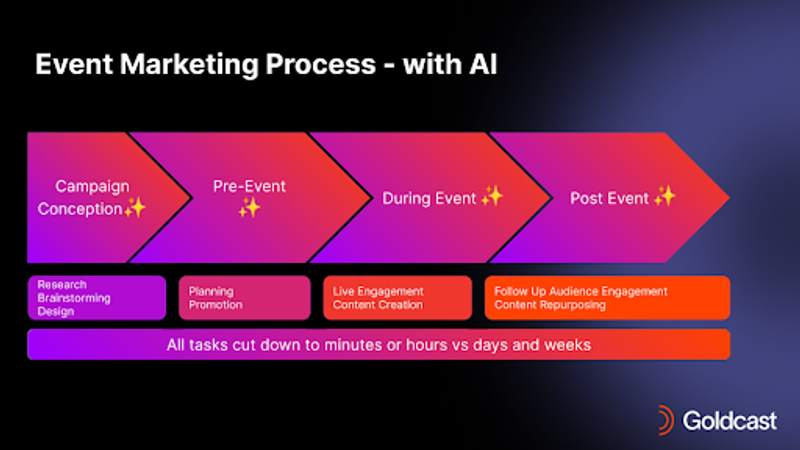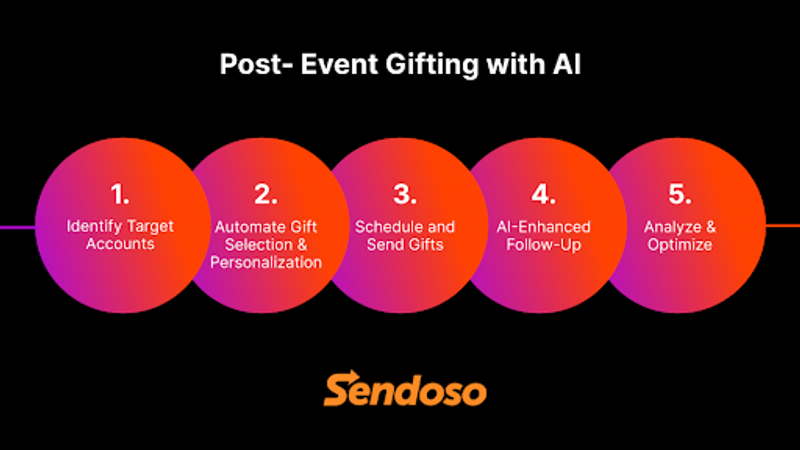How To Use AI Throughout the Entire Event Marketing Process For Powerful Results

Table of Contents
Maximize Your Marketing ROI
Join 10,000 other marketers already getting the best tips on running engaging events that boost pipeline and create raving fans.
We know lots of people who are using AI for at least one part of the event marketing process—namely, repurposing content afterward with Content Lab. 😉
But what about all the other parts? How can AI help during the entire pre- and post-event process, as well as during the event itself?
In our recent event, "AI for Streamlined Enterprise Marketing," Kelly Cheng, Goldcast's Head of Marketing, shared examples of how Goldcast and other marketing teams are using AI tools to revolutionize the traditional event marketing process.
Read on for these tips:
- The event process: How it started vs how it's going
- Use AI pre-event for planning and design
- Use AI during your event to boost engagement
- Use AI post-event for repurposed content, gifting, and ABM
- AI transforms every step of the event marketing process
- AI for the Event Marketing Process: FAQs
Psst: If you'd like to watch the full replay, have at it below!
The event process: How it started vs how it's going
You're likely very familiar with the traditional event marketing process, which starts with campaign conception, moves into pre-event planning, centers around a hosted event, and then ends with the post-event tasks.
Take a look below as Kelly walks us through how AI has transformed this process, end to end:
Let's dive in a little deeper about what each phase of the event marketing process entails and how AI is changing it up.
The traditional event marketing process

Typically, the campaign conception phase involved a lot of research and brainstorming with various teams. You might spend anywhere from one week to an entire month getting everything in order to move to the actual planning phase.
Then, once you were ready to make some firm plans, it was time to start promoting the event and getting the word out there so people could sign up and spread the word about your event. This might take anywhere from half a month to another full month.
At this point, you've already spent up to two months working on the event, and it hasn't even happened yet.
Then, it's Event Day. Most events last about an hour, during which time you're laser-focused on keeping engagement up and making sure everything runs smoothly.
After the event, your team might spend anywhere from a week to two weeks following up with registrants, sending surveys, working to repurpose content, and tying up loose ends. For some teams—particularly if the event contained multiple sessions—this phase could take much longer.
Event marketing with AI

With AI, the entire process stays the same, but AI adds that little bit of sparkle you didn't even know you were missing ✨
The biggest difference? Everything takes you minutes or hours versus weeks and months.
And yes, we know that sounds too good to be true, but we promise this is very doable, no matter your comfort level with tech.
Let's talk next about specific ways you can use AI throughout the event marketing journey.
Use AI pre-event for planning and design
To get an idea for how marketers are using AI in the pre-event stages, we asked members of The Event Marketers Club to spill the tea on their best practices.
Here's what folks are using AI for:
- Help with brainstorming and generating titles, subject lines, and content concepts
- Identifying which engagement activations might work best (virtual vs in-person or hybrid)
- Iterating existing copy
- Categorizing and organizing information
- Drafting outlines for events
- Suggestions on how to tighten up a draft
- Grammar checks
- Building marketing campaigns and messaging templates for trade shows
- Drafting RFPs, sponsorship decks, and event landing pages
- Generating thoughtful polling and survey questions
This is a wide range of ideas that really demonstrates the versatility of AI. If you've got a task eating up your time, it's likely that you can experiment with using AI to take some of it off your plate.
Event design

There are also lots of great ways to use AI to help with your event design. AI tools can render images quickly, ensure consistency in your design, and push out some high-quality stuff without needing to hire a design team or agency.
This saves you time and money and leaves you with some good looking assets.
Some tools we recommend:
- Canva: A versatile tool that integrates AI features to help automate the design process
- Beautiful.ai: Helpful for putting together visually appealing slide presentations
- Visual Electric, Ideogram, Leonardo.ai: Check out these AI image generators to create images and characters for your event branding. These can also reduce the complexity and risks associated with copyright laws for images you find on other sites!
Use AI during your event to boost engagement
During our events, the Goldcast team is focused on making sure people are as engaged as possible. AI tools can help.
Our friends at Qualified recently released an AI-powered SDR agent named Piper. Piper can autonomously converse with your attendees during the event and then afterward, you can use a custom URL with Piper attached to it to follow up with attendees.
If someone follows that link after the event concludes, Piper will recognize they've come from your event and naturally continue the conversation, driving the attendee to the CTA you've picked out. This is a super unique, forward-thinking use case for AI in the events world.
Use AI post-event for repurposed content, gifting, and ABM
Once your event ends, AI really takes center stage.
We want to introduce you to Goldcast Smart Events, an all-in-one AI solution built in the Goldcast platform that helps streamline all of these post-event activities. After your event ends, Smart Events whips up video clips, social posts, blogs, follow-up emails, and an on-demand page—without any effort from you!
Remember that as awesome as these assets are, you don't want to rush to publish something that AI comes up with without checking it over first. We view AI content as a working draft, and it helps kickstart our post-event activity—but it still does require that human touch.
Video content
One thing is particularly worth calling out, and that's the video content that AI tools can produce after your event. With Smart Events and Content Lab, you get social posts that are full of videos, which are great for social engagement.
On LinkedIn, video posts get 5x engagement vs regular text or image posts, and people are 2x more likely to share video content than other types!
You should also add video clips and snippets into blog posts, the way we've done with this one. Videos are 50x more likely to rank on Google than plain text posts. This can help turbocharge your Google search ranking and make your content more engaging for readers.
Post-event gifting
If you want to share the love after an event and thank folks for coming, sending a gift is a great way to show appreciation. And—you guessed it—AI is your friend here!

With Sendoso, you can lean on AI to identify your high-impact accounts. From there, the platform makes it easy to personalize gifts based on attendee data. Sendoso deploys AI research across the web to find out, for example, if your prospect is a tea aficionado and would love to try the latest matcha brand to hit the market.
Sendoso also determines the optimal time for sending the gift, helps you with follow-up, and analyzes your results so you can iterate next time.
Improve account-based marketing (ABM)
Here's a great example from 6sense that illustrates how AI can improve account-based outreach:
As you can see, 6sense leverages AI to segment attendees and prioritize who should be followed up with first after an event. This helps your sales and marketing teams focus on the strongest leads with the highest chance of conversion.
For all other leads, a conversational email goes out. This way, everyone is receiving some sort of follow-up, but your sales folks are investing their time as wisely as possible.
AI transforms every step of the event marketing process
As Tanya Budgell of Assent pointed out during the event, AI saves you major time. Eleven days into the month, she'd already saved a whopping 78 hours using AI to lighten her workload—while not sacrificing a bit of quality.
Amazing results like that are available to you, too. We're no gatekeepers! If you want to learn more about Goldcast Smart Events, click here to get started. And don't forget to catch up with the full session on AI below!
Transform Your Video Marketing with AI
Stay In Touch
Platform
Resources
© 2026 Copyright Goldcast, Inc. All rights reserved.





 Upcoming Events
Upcoming Events Event Series
Event Series On-Demand Events
On-Demand Events

